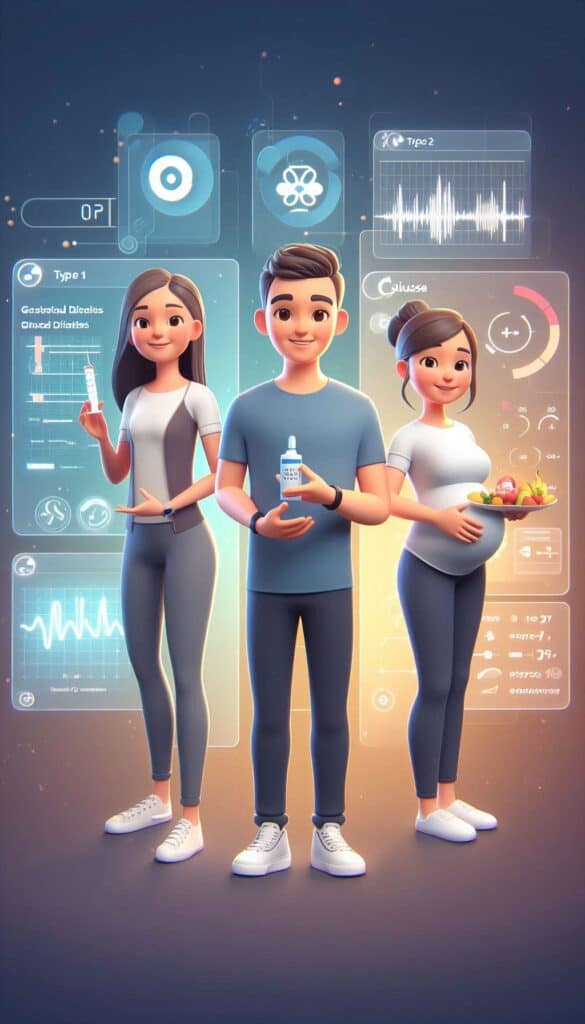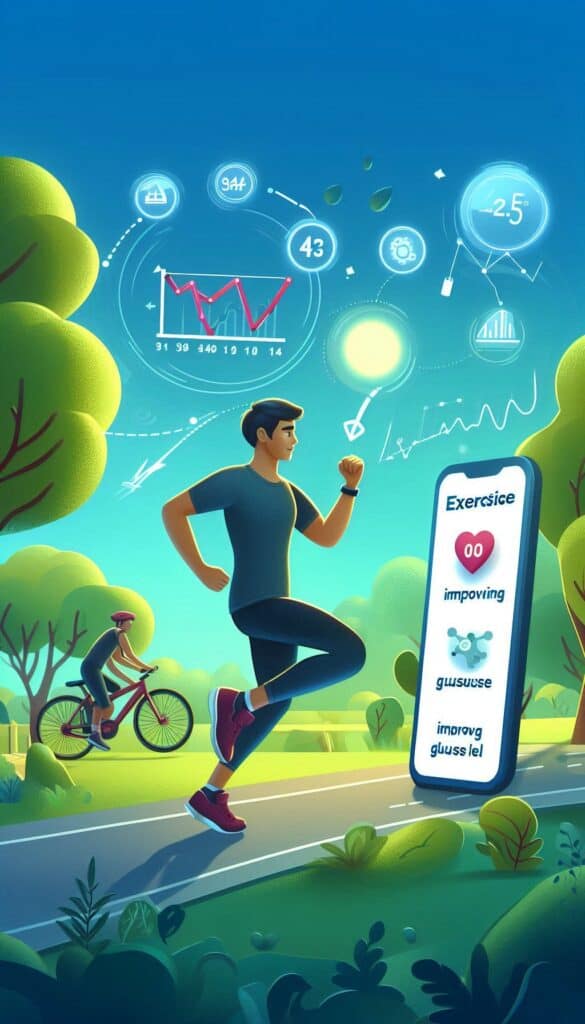Blood sugar, or glucose, is a crucial energy source for the body’s cells, derived from our food. It is essential for brain function, muscle performance, and overall energy levels.
The body meticulously regulates blood sugar levels through insulin, a hormone the pancreas produces. Insulin ensures that glucose is used immediately for energy or stored for future use.
When this delicate balance is disrupted, it can lead to significant health issues, emphasizing the importance of maintaining optimal blood sugar levels for overall well-being.
Diabetes is characterized by the body’s inability to regulate blood sugar effectively. This occurs either because the pancreas does not produce enough insulin or the body cannot use it effectively.
There are several types of diabetes, each with its unique causes and risk factors. Regardless of the kind, the common thread is the challenge of managing blood sugar levels.
Left uncontrolled, diabetes can lead to severe complications, including heart disease, nerve damage, and kidney failure.
Understanding how blood sugar works and how diabetes affects it is essential for managing the condition and maintaining health.
This article aims to provide a foundational understanding of blood sugar and its role in the body while offering practical management tips.
By demystifying the science behind blood sugar and diabetes, we hope to empower readers with the knowledge they need to make informed decisions about their health.
This guide is designed to support individuals in their journey toward better blood sugar control and overall health. It covers critical concepts, different types of diabetes, and practical management strategies.
Through education and awareness, we can take proactive steps to manage blood sugar levels and mitigate the risks associated with diabetes.

What is Blood Sugar?
Blood sugar, or glucose, is a vital energy source for the body’s cells. It comes from the food we eat, primarily carbohydrates, and is transported through the bloodstream for energy or storage for future use.
Glucose is essential for brain function, muscle activity, and cellular operations. Without adequate glucose levels, the body cannot perform its vital functions efficiently, leading to fatigue, confusion, and other health issues.
The body regulates blood sugar levels through a finely tuned system involving the pancreas and insulin. After eating, blood sugar levels rise, prompting the pancreas to release insulin. Insulin acts as a key, allowing glucose to enter cells and be used for energy.
If there’s excess glucose, insulin helps store it in the liver and muscles as glycogen for later use. When blood sugar levels drop between meals or during physical activity, the pancreas releases another hormone called glucagon, which signals the liver to release stored glucose, ensuring a steady energy supply.
Understanding the difference between glucose and insulin is crucial. Glucose is the sugar that circulates in the blood, providing energy to cells, while insulin is the hormone that facilitates glucose uptake into cells.
Without insulin or ineffective insulin, glucose cannot enter cells and stays in the bloodstream, leading to high blood sugar levels.
This imbalance is a hallmark of diabetes, where the regulation of blood sugar is compromised, requiring careful management to maintain health and prevent complications.
Types of Diabetes

Type 1 Diabetes
Diabetes is a complex condition with several types, each with distinct causes and characteristics. Type 1 Diabetes is an autoimmune condition where the body’s immune system mistakenly attacks and destroys the insulin-producing cells in the pancreas.
This leads to an absolute insulin deficiency, making it necessary for individuals to take insulin injections for life.
Type 1 Diabetes is typically diagnosed in children and young adults, although it can occur at any age. Its onset is usually sudden, and the exact cause remains unknown, though genetic and environmental factors are believed to play a role.
Type 2 Diabetes
Type 2 Diabetes is the most common form of diabetes and usually develops in adults over the age of 45.
However, it is increasingly being diagnosed in younger individuals, including children and adolescents. This type of diabetes results from the body’s inability to use insulin effectively, often due to insulin resistance.
Over time, the pancreas cannot produce enough insulin to maintain normal blood glucose levels. Key risk factors for Type 2 Diabetes include obesity, physical inactivity, age, family history, and certain ethnic backgrounds.
Unlike Type 1, Type 2 Diabetes can often be managed through lifestyle changes, oral medications, and sometimes insulin.
Gestational Diabetes
Gestational Diabetes occurs during pregnancy when the body cannot produce enough insulin to meet the increased needs, leading to high blood sugar levels.
This type of diabetes usually develops around the 24th to 28th week of pregnancy and generally resolves after childbirth.
However, it increases the risk of developing Type 2 Diabetes later in life for both the mother and child.
Risk factors for gestational diabetes include being overweight, having a family history of diabetes, and having had gestational diabetes in a previous pregnancy.
Proper management is crucial to ensure the health and well-being of both mother and baby during and after pregnancy.
Symptoms of High and Low Blood Sugar
Hyperglycemia, or high blood sugar, presents with symptoms that can include frequent urination, excessive thirst, blurred vision, fatigue, and headaches.
Over time, persistent hyperglycemia can lead to more severe complications such as nerve damage, kidney disease, and cardiovascular issues.
Recognizing these early symptoms is critical for timely management, as it allows individuals to take action before the condition worsens.
By monitoring blood sugar levels and making necessary lifestyle adjustments, people can prevent or minimize the long-term health impacts of high blood sugar.
On the other hand, hypoglycemia, or low blood sugar, can cause symptoms such as shakiness, sweating, rapid heartbeat, dizziness, and confusion.
In severe cases, hypoglycemia can lead to loss of consciousness or seizures. Immediate recognition and management of low blood sugar are vital to avoid these dangerous outcomes.
Individuals with diabetes or those prone to hypoglycemia should be aware of these symptoms and know how to respond quickly, such as consuming fast-acting carbohydrates like glucose tablets or fruit juice.
Timely recognition and management of hyperglycemia and hypoglycemia are essential for maintaining overall health and preventing complications.
Importance of Blood Sugar Monitoring

Regular blood sugar monitoring is crucial for individuals with diabetes or those at risk of developing the condition. By closely monitoring blood sugar levels, individuals can make informed decisions about their health and take proactive steps to maintain optimal glucose levels.
Monitoring helps identify patterns and trends, allowing for timely diet, medication, and lifestyle adjustments to prevent complications.
Consistent blood sugar checks can also provide valuable feedback on how different foods, activities, and stressors affect glucose levels, enabling better overall management of the condition.
There are several methods available for monitoring blood sugar levels. Traditional glucometers require a small blood sample to measure glucose levels, usually obtained from a finger prick.
This method is straightforward and provides immediate results. On the other hand, continuous glucose monitors (CGMs) use a tiny sensor inserted under the skin to track glucose levels continuously throughout the day and night.
CGMs offer the advantage of providing real-time data and alerts for high or low blood sugar, reducing the risk of unexpected spikes or drops. Both methods have benefits, and the choice depends on individual preferences and needs.
Monitoring blood sugar levels can significantly inform dietary and lifestyle choices. For example, individuals can identify which meals cause spikes by tracking glucose responses to different foods and adjusting their diet accordingly.
Monitoring can also highlight the impact of physical activity on blood sugar levels, encouraging regular exercise as part of diabetes management.
Additionally, understanding the effects of stress and sleep on glucose levels can lead to healthier lifestyle habits.
Overall, regular blood sugar monitoring empowers individuals to take control of their health and make informed decisions to maintain stable glucose levels and prevent complications.
Dietary Tips for Managing Blood Sugar

Balanced Diet
Managing blood sugar effectively begins with maintaining a balanced diet that includes the right mix of macronutrients: carbohydrates, proteins, and fats.
Carbohydrates are the body’s primary energy source, but they must be consumed in moderation and paired with proteins and fats to prevent rapid spikes in blood sugar levels. Proteins help with the body’s growth and repair and slow down carbs’ absorption, leading to more stable blood sugar levels.
Fats are essential for cell function and hormone production. They can also help maintain a feeling of fullness, which prevents overeating.
By balancing these macronutrients, individuals can support steady blood sugar levels and overall health.
Low Glycemic Index Foods
Incorporating low glycemic index (GI) foods into your diet is another critical strategy for managing blood sugar. The glycemic index ranks how quickly a carbohydrate-containing food raises blood glucose levels after consumption.
Foods with a low GI (55 or less) are digested and absorbed more slowly, causing a gradual rise in blood sugar levels.
Examples include whole grains, legumes, and most fruits and vegetables. Choosing low-GI foods helps maintain consistent blood sugar levels, reducing the risk of spikes and crashes.
This approach not only aids in blood sugar management but also supports long-term health and well-being.
Meal Planning
Meal planning is crucial to managing blood sugar, emphasizing the importance of portion control and regular meal timing.
Eating balanced meals at consistent intervals helps prevent extreme fluctuations in blood sugar levels. Portion control ensures that you don’t consume more carbohydrates than your body can handle at one time, which is particularly important for people with diabetes.
Regular meal timing regulates the body’s internal clock and metabolic processes, leading to more predictable blood sugar responses.
Planning meals allows for a thoughtful selection of ingredients and portion sizes, ultimately supporting better blood sugar control and overall health.
Lifestyle Changes for Better Blood Sugar Control

Exercise
Exercise is a powerful tool for managing blood sugar levels and improving overall health. Physical activity helps the body use insulin more efficiently, making it easier to control blood sugar levels.
It also increases glucose uptake by muscle cells, reducing the amount of sugar in the bloodstream. Regular exercise, such as walking, cycling, or strength training, can help prevent spikes in blood sugar after meals and improve long-term blood sugar control.
Additionally, exercise promotes cardiovascular health, aids in weight management, and enhances overall well-being, making it a cornerstone of diabetes management.
Stress Management
Managing stress is equally essential for maintaining stable blood sugar levels. Stress triggers the release of hormones like cortisol and adrenaline, which can raise blood sugar levels.
Chronic stress can lead to prolonged periods of elevated blood sugar, increasing the risk of complications.
Stress management techniques such as meditation, yoga, and deep-breathing exercises can help reduce stress and promote relaxation.
These practices calm the mind and body, lower cortisol levels, and create a more balanced physiological state, crucial for blood sugar regulation.
Sleep
Quality sleep plays a vital role in blood sugar regulation as well. Poor sleep can disrupt the body’s ability to use insulin effectively, leading to higher blood sugar levels.
Inadequate sleep also increases the production of stress hormones and appetite-regulating hormones, which can contribute to weight gain and insulin resistance.
Prioritizing good sleep hygiene, such as maintaining a regular sleep schedule, creating a restful sleep environment, and avoiding stimulants before bedtime, can help improve sleep quality and support better blood sugar control.
Consistently getting enough quality sleep ensures that the body functions optimally, promoting overall health and well-being.
Conclusion
Understanding blood sugar and its role in the body is crucial for effective diabetes management. Keeping blood sugar levels within a healthy range prevents complications and supports overall well-being.
This article has delved into various aspects of blood sugar management, from defining blood sugar and explaining its regulation to identifying the different types of diabetes and their associated risks.
By recognizing the symptoms of high and low blood sugar and the importance of regular monitoring, individuals can take informed steps to manage their condition.
Additionally, dietary tips and lifestyle changes, such as balanced eating, regular exercise, and stress management, play a vital role in maintaining stable blood sugar levels.
Taking proactive steps to monitor and manage blood sugar is essential for those living with diabetes or at risk of developing the condition.
Regular blood sugar checks, mindful dietary choices, consistent physical activity, and quality sleep are foundational to maintaining health.
Embracing these practices empowers individuals to take control of their health journey, reducing the risk of complications and enhancing their quality of life.
By staying informed and vigilant, individuals can navigate the challenges of diabetes management with confidence and resilience, ensuring a healthier and more balanced future.




